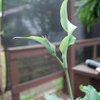Commercial compost question!
Janice
16 years ago
Related Stories

HOUSEKEEPING10 Chores You Can Whip Through During Commercials
Use ad time for getting tasks done, and it’s like fast-forwarding your house into cleanliness
Full Story
GARDENING GUIDESGet on a Composting Kick (Hello, Free Fertilizer!)
Quit shelling out for pricey substitutes that aren’t even as good. Here’s how to give your soil the best while lightening your trash load
Full Story
GARDENING GUIDESNo-Regret Plants: 5 Questions Smart Shoppers Ask
Quit wasting money and time at the garden center. This checklist will ensure that the plants you're eyeing will stick around in your yard
Full Story

KITCHEN DESIGN9 Questions to Ask When Planning a Kitchen Pantry
Avoid blunders and get the storage space and layout you need by asking these questions before you begin
Full Story
REMODELING GUIDES13 Essential Questions to Ask Yourself Before Tackling a Renovation
No one knows you better than yourself, so to get the remodel you truly want, consider these questions first
Full Story
WORKING WITH PROS12 Questions Your Interior Designer Should Ask You
The best decorators aren’t dictators — and they’re not mind readers either. To understand your tastes, they need this essential info
Full Story
GREEN BUILDINGConsidering Concrete Floors? 3 Green-Minded Questions to Ask
Learn what’s in your concrete and about sustainability to make a healthy choice for your home and the earth
Full Story
ORGANIZINGPre-Storage Checklist: 10 Questions to Ask Yourself Before You Store
Wait, stop. Do you really need to keep that item you’re about to put into storage?
Full Story
SELLING YOUR HOUSE15 Questions to Ask When Interviewing a Real Estate Agent
Here’s what you should find out before selecting an agent to sell your home
Full Story









esther_opal
JaniceOriginal Author
Related Professionals
Hyattsville Landscape Architects & Landscape Designers · Pelham Landscape Contractors · Bloomington Landscape Contractors · College Park Landscape Contractors · Cordele Landscape Contractors · Natick Landscape Contractors · Pacifica Landscape Contractors · Sammamish Landscape Contractors · Watertown Landscape Contractors · Antioch Landscape Contractors · Laguna Beach Fence Contractors · Marana Fence Contractors · Teaneck Fence Contractors · San Lorenzo Fence Contractors · Dana Point Solar Energy SystemsJaniceOriginal Author
esther_opal
maryann_____chgo
ken_adrian Adrian MI cold Z5
lindac
nchostaqueen
esther_opal
esther_opal
esther_opal
JaniceOriginal Author
maryann_____chgo
esther_opal
JaniceOriginal Author
esther_opal
ken_adrian Adrian MI cold Z5
JaniceOriginal Author
maryann_____chgo
JaniceOriginal Author
esther_opal
ken_adrian Adrian MI cold Z5
esther_opal
JaniceOriginal Author
ken_adrian Adrian MI cold Z5
esther_opal
JaniceOriginal Author
Carole Westgaard
JaniceOriginal Author
esther_opal
Carole Westgaard
Carole Westgaard
esther_opal
goldedger
JaniceOriginal Author